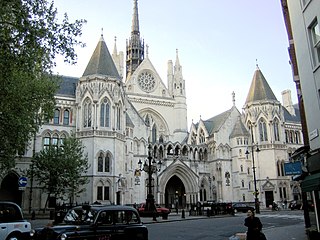Liquidation is the process in accounting by which a company is brought to an end in the United Kingdom, Republic of Ireland and United States. The assets and property of the company are redistributed. Liquidation is also sometimes referred to as winding-up or dissolution, although dissolution technically refers to the last stage of liquidation. The process of liquidation also arises when customs, an authority or agency in a country responsible for collecting and safeguarding customs duties, determines the final computation or ascertainment of the duties or drawback accruing on an entry.
In law, receivership is a situation in which an institution or enterprise is held by a receiver—a person "placed in the custodial responsibility for the property of others, including tangible and intangible assets and rights"—especially in cases where a company cannot meet financial obligations or enters bankruptcy. The receivership remedy is an equitable remedy that emerged in the English chancery courts, where receivers were appointed to protect real property. Receiverships are also a remedy of last resort in litigation involving the conduct of executive agencies that fail to comply with constitutional or statutory obligations to populations that rely on those agencies for their basic human rights.

A security interest is a legal right granted by a debtor to a creditor over the debtor's property which enables the creditor to have recourse to the property if the debtor defaults in making payment or otherwise performing the secured obligations. One of the most common examples of a security interest is a mortgage: When person, by the action of an expressed conveyance, pledges by a promise to pay a certain sum of money, with certain conditions, on a said date or dates for a said period, that action on the page with wet ink applied on the part of the one wishing the exchange creates the original funds and negotiable Instrument. That action of pledging conveys a promise binding upon the mortgagee which creates a face value upon the Instrument of the amount of currency being asked for in exchange. It is therein in good faith offered to the Bank in exchange for local currency from the Bank to buy a house. The particular country's Bank Acts usually requires the Banks to deliver such fund bearing negotiable instruments to the Countries Main Bank such as is the case in Canada. This creates a security interest in the land the house sits on for the Bank and they file a caveat at land titles on the house as evidence of that security interest. If the mortgagee fails to pay defaulting in his promise to repay the exchange, the bank then applies to the court to for-close on your property to eventually sell the house and apply the proceeds to the outstanding exchange.

The Bankruptcy and Insolvency Act ("BIA") is one of the statutes that regulates the law on bankruptcy and insolvency in Canada. It governs bankruptcies, consumer and commercial proposals, and receiverships in Canada.
In law, a voidable floating charge refers to a floating charge entered into shortly prior to the company going into liquidation which is void or unenforceable in whole or in part under applicable insolvency legislation.
As a legal concept, administration is a procedure under the insolvency laws of a number of common law jurisdictions, similar to bankruptcy in the United States. It functions as a rescue mechanism for insolvent entities and allows them to carry on running their business. The process – in the United Kingdom colloquially called "under administration" – is an alternative to liquidation, or may be a precursor to it. Administration is commenced by an administration order. A company in administrative receivership is operated by an administrator on behalf of its creditors. The administrator may recapitalize the business, sell the business to new owners, or demerge it into elements that can be sold and close the remainder. Most countries distinguish between voluntary (board-decided) and involuntary (court-decided) receivership. In voluntary administrative receivership, the administrator is appointed by the company directors. In involuntary administrative receivership, the administrator is appointed by a judicial court. The legal terms for these processes vary from country to country, and the processes may overlap.

United Kingdom insolvency law regulates companies in the United Kingdom which are unable to repay their debts. While UK bankruptcy law concerns the rules for natural persons, the term insolvency is generally used for companies formed under the Companies Act 2006. "Insolvency" means being unable to pay debts. Since the Cork Report of 1982, the modern policy of UK insolvency law has been to attempt to rescue a company that is in difficulty, to minimise losses and fairly distribute the burdens between the community, employees, creditors and other stakeholders that result from enterprise failure. If a company cannot be saved it is "liquidated", so that the assets are sold off to repay creditors according to their priority. The main sources of law include the Insolvency Act 1986, the Insolvency Rules 1986 ), the Company Directors Disqualification Act 1986, the Employment Rights Act 1996 Part XII, the Insolvency Regulation (EC) 1346/2000 and case law. Numerous other Acts, statutory instruments and cases relating to labour, banking, property and conflicts of laws also shape the subject.

Examinership is a process in Irish law whereby the protection of the Court is obtained to assist the survival of a company. It allows a company to restructure with the approval of the High Court.

Illingworth v Houldsworth [1904] AC 355 is a UK insolvency law case, concerning the taking of a security interest over a company's assets with a floating charge. In the Court of Appeal Romer LJ held that a key to a floating charge, as opposed to a fixed charge was that the company can carry on its business with assets subject to the charge.

Powdrill v Watson [1995] 2 AC 394 is a UK insolvency law case concerning the administration procedure when a company is unable to repay its debts.

Downsview Nominees Ltd v First City Corp Ltd [1992] UKPC 34 is a New Zealand insolvency law case decided by the Judicial Committee of the Privy Council concerning the nature and extent of the liability of a mortgagee, or a receiver and manager, to a mortgagor or a subsequent debenture holder for his actions.
Administration in United Kingdom law refers to the main kind of procedure in UK insolvency law when a company is unable to pay its debts. The management of the company is usually replaced by an insolvency practitioner whose statutory duty is to rescue the company, save the business, or get the best result possible. It is the equivalent of Chapter 11, Title 11, United States Code, although with significant differences. While creditors with a security interest over all a company's assets could control the procedure previously through receivership, the Enterprise Act 2002 made administration the main procedure.

Buchler v Talbot[2004] UKHL 9 is a UK insolvency law case, concerning the priority of claims in a liquidation. Under English law at the time the expenses of liquidation took priority over the preferred creditors, and the preferred creditors took priority over the claims of the holder of a floating charge. However, a crystallised floating charge theoretically took priority over the liquidation expenses. Accordingly the courts had to try and reconcile the apparent triangular conflict between priorities.

British Virgin Islands company law is primarily codified in the BVI Business Companies Act, 2004, and to a lesser extent by the Insolvency Act, 2003 and the Securities and Investment Business Act, 2010. The British Virgin Islands has approximately 30 registered companies per head of population, which is probably the highest ratio of any country in the world. Annual company registration fees provide a significant part of Government revenue in the British Virgin Islands, which accounts for the comparative lack of other taxation. Accordingly, company law forms a much more prominent part of the law of the British Virgin Islands than might otherwise be expected.

Cayman Islands bankruptcy law is principally codified in five statutes and statutory instruments:
Australian insolvency law regulates the position of companies which are in financial distress and are unable to pay or provide for all of their debts or other obligations, and matters ancillary to and arising from financial distress. The law in this area is principally governed by the Corporations Act 2001. Under Australian law, the term insolvency is usually used with reference to companies, and bankruptcy is used in relation to individuals. Insolvency law in Australia tries to seek an equitable balance between the competing interests of debtors, creditors and the wider community when debtors are unable to meet their financial obligations. The aim of the legislative provisions is to provide:
Provisional liquidation is a process which exists as part of the corporate insolvency laws of a number of common law jurisdictions whereby after the lodging of a petition for the winding-up of a company by the court, but before the court hears and determines the petition, the court may appoint a liquidator on a "provisional" basis. Unlike a conventional liquidator, a provisional liquidator does not assess claims against the company or try to distribute the company's assets to creditors, as the power to realise the assets comes after the court orders a liquidation.

Hong Kong insolvency law regulates the position of companies which are in financial distress and are unable to pay or provide for all of their debts or other obligations, and matters ancillary to and arising from financial distress. The law in this area is now primarily governed by the Companies Ordinance and the Companies Rules. Prior to 2012 Cap 32 was called the Companies Ordinance, but when the Companies Ordinance came into force in 2014, most of the provisions of Cap 32 were repealed except for the provisions relating to insolvency, which were retained and the statute was renamed to reflect its new principal focus.












